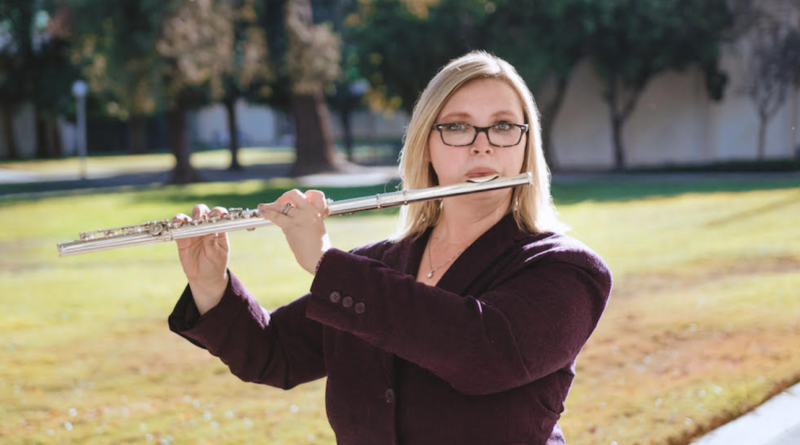Forever Young – Adult Flute Students
by Rachel Taylor Geier, DMA
I received a comment on my flute blog several years ago from a reader that read, “I wish you would use some images of OLDER people playing the flute & issues to do with being a mature player… The flute is NOT only for young people.” I could not agree more. Some of my very best students have been older adult players. I have even taught adult students who were learning to play the flute at the same time as their children (this made for some very fun family group lessons!). The strengths and challenges that adult students encounter are very different than those of younger students but, with the right approach, playing the flute can be an extremely rewarding and meaningful experience for learners of any age. In this article, I will be discussing the unique issues that crop up for adult flute students and how flute teachers may best support older students to effectively set and attain all of their flute playing goals. You are never too old to learn to play the flute!
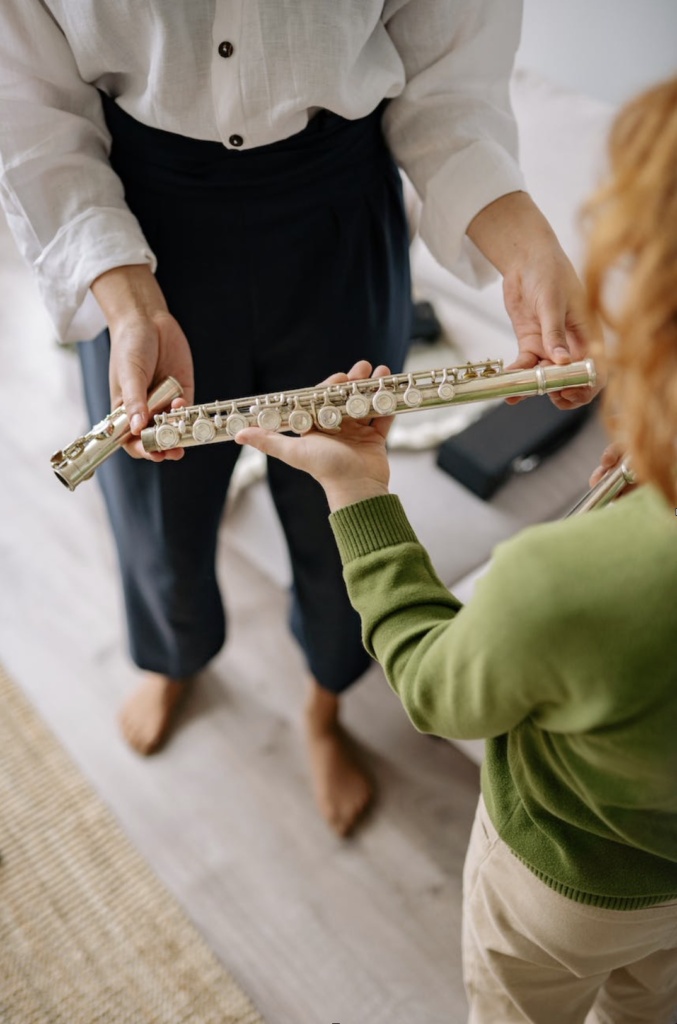
Photo by Yan Krukau on Pexels.com
One of the biggest differences between younger and older students is the correlation between motivation and energy. It is often difficult to motivate younger students to practice in the early stages of their flute study. I believe that this lack of motivation is simply because they do not know yet what they can achieve through dedicated practice. Or, in other words, they cannot envision the finish line. A flute teacher’s challenge with younger players is to motivate through listening activities, practice card assignments, masterclass participation, concert attendance, and other goal-setting projects. Once a younger student is properly motivated, they are equipped with an endless supply of youthful energy to follow through with practice requirements, audition preparations, and competition assignments. Older students, on the other hand, are motivated from the beginning. Chances are they have listened to classical music for the majority of their lives and are familiar with some of the greatest flutists of our time (Rampal, Galway, etc.). They know how to research information about the flute, find flute recordings, and have a treasure trove of pieces and tunes that they have wanted to play for years. Adult learners are ready to learn and can quickly identify some of their unique flute playing goals. The challenge for older learners, however, is pacing their time and energy. Adults with career and/or family responsibilities may struggle to fit in enough practice time to achieve their goals or may be so exhausted by the end of the day that devoting time to the flute is nearly impossible. Retired adult learners have more time to devote to practice but likely have a dwindling supply of energy and may also have physical limitations such as arthritis or shortness of breath. They may also become impatient with the process of learning and frustrated that they are not progressing fast enough. A good way to address time and energy obstacles is to come up with a reasonable game plan for your adult students. If time is the biggest concern, sit down with your student and devise a reasonable practice schedule. Perhaps there is a quiet room in the house where they can practice for 30-60 minutes in the evening after the kids have gone to sleep (an insulated garage area would work well for such a space). Or maybe they can devote 30-60 minutes to practice early in the morning before the hassles of the workday begin. If energy is the primary issue, structure their lessons and practice sessions to include a 5-minute break for every 10 minutes of playing to rest muscles and reenergize. It is important to remind older players that it is far more important to practice regularly in small doses than cram practice on the weekends. Adult learners must take it easy and enjoy the slower moving learning process.
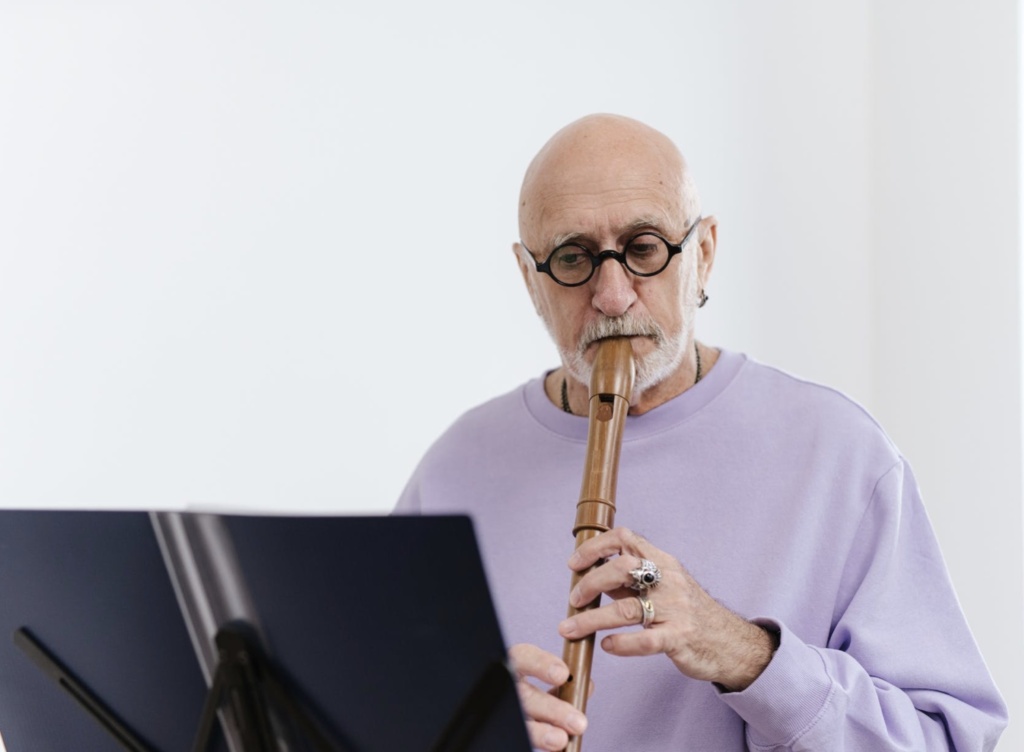
Photo by SHVETS production on Pexels.com
Stretching and Warmups. It is very important for older flute students to stretch their muscles before playing to avoid any injuries. A simple stretching exercise is to make a gentle fist, wrapping your thumb across your fingers, hold for 30-60 seconds, and release, spreading your fingers wide. Repeat 4-5 times. You may also use a tennis ball or a stress ball, squeeze for a few seconds, and release. (Repeat 4-5 times). After at least 5 minutes of stretching, ease into the practice session with simple octave exercises. As we age, our facial muscles become weaker and our embouchures less flexible, making octave leaps much more difficult. It is important for older adults to practice slow octaves to build these muscles back up gradually.
Another great exercise to help strengthen the embouchure is practicing harmonics. I recommend warming up with the top line on page 6 of the Trevor Wye Practice Book on Tone on a low C, C#, and D. It is important to reiterate to older students that harmonics are best achieved by gradually moving the lips forward and down rather than using more air. For many mature students, breathing is not as easy as it used to be, and it is quite exhausting to overuse air when you are already short of breath. Finally, after the embouchure is good and loose, have your students play slow scales to warm up the fingers. You may use good, old Taffanel and Gaubert Exercise #4, but the name of the game is to keep these scales slow. No speed competitions with older flutists! To quote the Tortoise, “Slow and steady. Steady and slow. That’s the way we ought to go.”

Photo by Andrea Piacquadio on Pexels.com
Supplies. Put.Down.The.Breathing.Bag. I know – just typing that made me want to send an apology note to my college flute professor. Many older adult students do not have the same air capacity as their younger counterparts and may become exhausted quite quickly. This is also why shorter bursts of playing followed by a resting period are necessary. It is important to have water handy to combat any dry mouth that may occur and to rejuvenate students during resting periods. If older students suffer from wrist injuries (such as tendonitis or carpal tunnel) or arthritis, it may also be helpful to wear wrist supports while playing. Cloth supports, in these instances, are much easier to wear while playing than the ones that feature metal or plastic supports. Make sure that older students use a comfortable, stable chair with supportive cushions and have a yoga mat handy in case of any back tension. It is perfectly acceptable to do an Alexander-style lay down exercise at the mid-point of the lesson.

Photo by Pixabay on Pexels.com
Key Extensions. Stiff muscles and arthritis are common ailments for older players. The flute that they use should not cause them any unnecessary pain. Make sure that the flute fits to their natural hand position and rests comfortably against any pressure points. I have raved about flute gels in the past and I think they are a must have for older players to prevent blistering. For players with larger hands, you may want to swap out flute gels for strips of mounting tape placed in layers at the point where both the left index finger and right thumb meet the flute, tailored to the natural position of the hand. I would also encourage your adult students to purchase key extensions which can be attached to the flute precisely where the fingers naturally fall. I also recommend that more mature players opt for an offset G flute rather than inline as modifications such as key extensions are easier to accommodate on an offset G model. Finally, make sure that any flute your student plays on is good working condition. Nobody should be learning on an instrument that does not work properly.
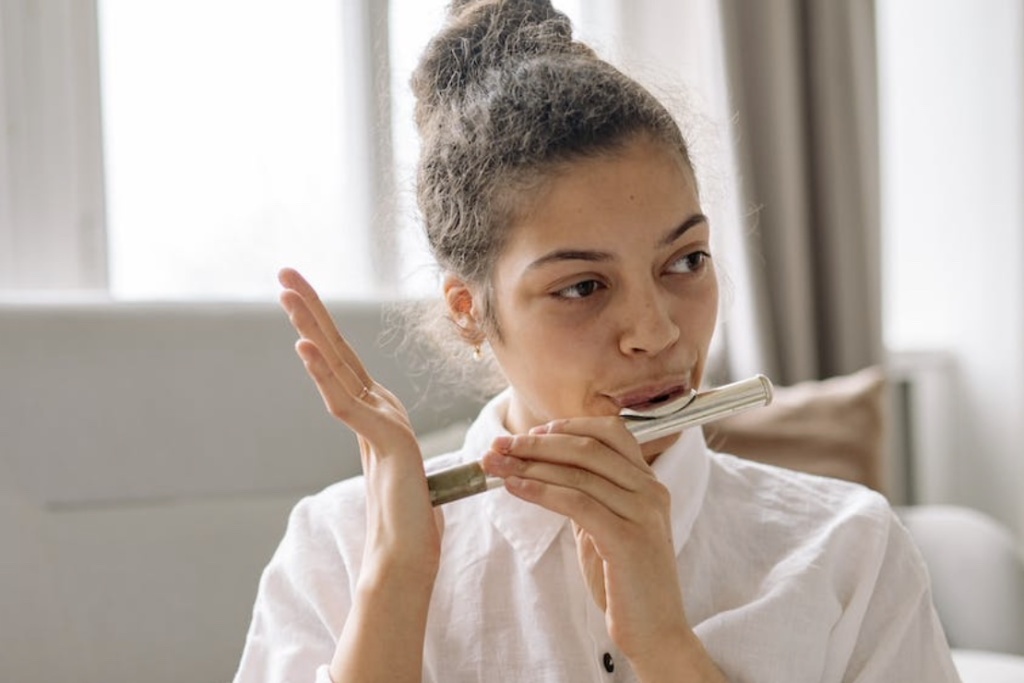
Photo by Yan Krukau on Pexels.com
Emphasize discussion and interpretation over rote technical exercises. This is where your adult students can be your greatest teachers. Older students learn to play the flute at later stages in life for various reasons, but often there is an underlying story about the role that music has already played in their lives. This helps them understand the music they play from a much deeper interpretive level than a younger player. They might even tell you something about music that you had never thought about before! Rather than giving them scales to drill or a long list of excerpts to memorize, shift focus onto musical understanding and interpretive meanings. For example, begin each lesson by outlining the concepts you will be working on that day (much like an agenda at a business meeting), and discuss any ideas, insights, or questions that your student may have had since their last lesson. Adult students really value the expertise of a good teacher and always look forward to talking shop. Record your lessons using an iPhone audio or video app and send these files to your adult students following their lessons so that they may refer back to them for clarification. Spend less time working on technique and more time rehearsing music that means something to them. Do they have a piece that always makes them smile? Is there a work that they have always wanted to play but never had an opportunity to learn in their youth? I believe that the greatest, most unique quality that an older flute student possesses is their highly developed power of interpretation. Tap into this and you will help them create music that truly speaks to their souls.

Photo by Pixabay on Pexels.com
Modifications. I am in my 40s and already find myself squinting at ledger lines on a regularly basis. Adult students may need to have certain modifications made to the size and darkness of their music to help them see the score a better. This, of course, can be accomplished using a standard printer or photocopier. Experiment with the placement of the music stand, particularly for students who wear bifocals. What works well for one student may not work at all for another. Finally, make sure that students who typically wear reading glasses have them handy during their lessons. I would even suggest keeping a pair or two of back-up glasses in your studio. Seeing is truly believing (or at least helpful in reading a score).
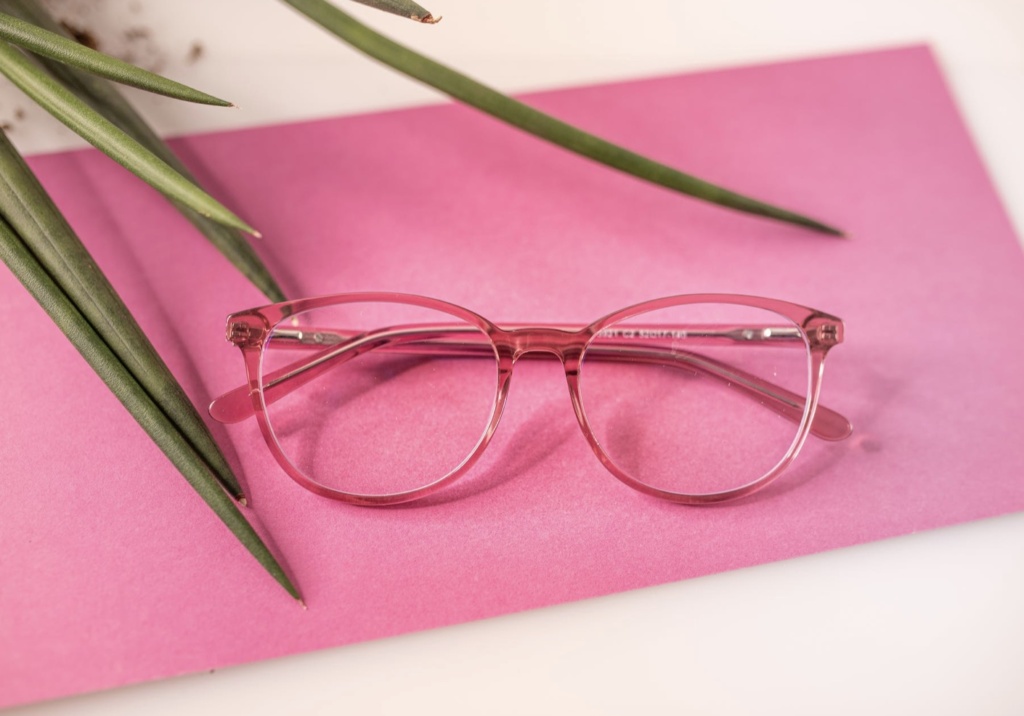
Photo by Dominika Roseclay on Pexels.com
******
There are numerous benefits associated with learning to play the flute at an advanced age. Learning any instrument keeps older adults mentally active (helping to fend off the onset of mental conditions such as Alzheimer). Playing the flute also helps maintain finger dexterity and muscle tone. On a more general level, learning to play the flute builds or rejuvenates a sense of self-esteem and brings focus to the day. Finally, playing meaningful music helps connect the adult learner with significant memories from the past, bringing them in touch with emotions that may have been buried for decades. Studying the flute at a later age provides a second chance to understand and experience music after life’s lessons have already been learned.
Happy Fluting!
****
Rachel Taylor Geier holds a DMA in Flute Performance from the University of Minnesota-Twin Cities, an MM in Flute Performance from San Francisco State University, and a BM in Music Performance from DePauw University. Former applied instructors include Immanuel Davis, Linda Lukas, Anne Reynolds, and Rhonda Bradetich. Dr. Geier currently teaches and freelances in Davis, California.
